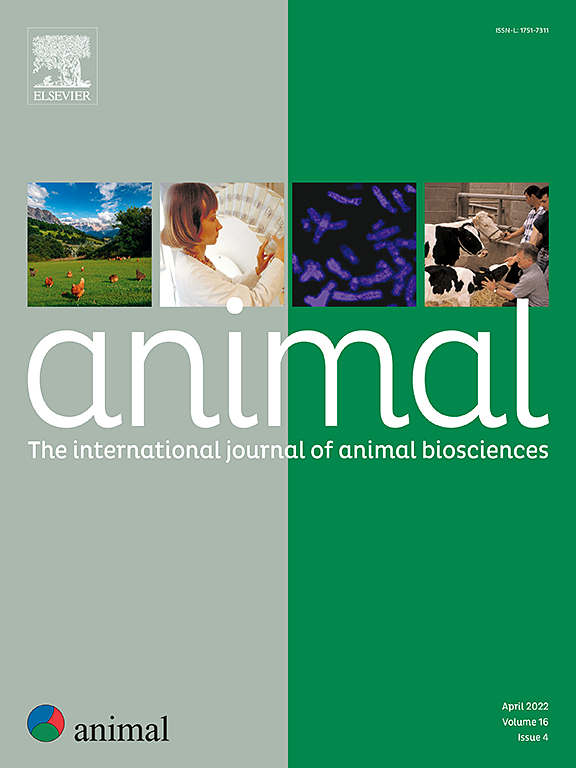屠宰重和性别对皮氏杂交猪胴体组成和营养物质效率的交互作用
IF 4
2区 农林科学
Q1 AGRICULTURE, DAIRY & ANIMAL SCIENCE
引用次数: 0
摘要
养猪业在将人类不可食用的蛋白质来源转化为可食用的动物蛋白质方面发挥着至关重要的作用。吸收的氮和磷有很大一部分随粪便排出;然而;这带来了环境挑战,特别是在集约化养猪生产地区。在评估生猪生产和管理策略的环境影响时,准确估计营养物质排泄是至关重要的。为此,了解管理如何影响体重构成是很重要的。本研究通过两个试验,研究了性别和屠宰体重对皮氏杂交种体成分和营养物质效率的影响。试验分四种性别:全公猪(EM)、母猪(BA)、免疫阉割猪(IC)和后备猪(GI)。实验1是在实验条件下(个体住房,营养丰富的饮食),而实验2是在控制农场环境下(群体住房,商业饮食)。试验1和试验2的屠宰体重分别为110 ~ 148 kg和99 ~ 138 kg。在生长-肥育期开始和结束时分析体成分。氮效率是根据吸收的氮转化为体内氮来计算的。总体而言,屠宰体重对BA体成分和营养物质排泄有明显影响,对GI的影响较小。相比之下,在测试体重范围内,屠宰体重对EM和IC的体成分和氮排泄没有影响。随着屠宰重的增加,粗蛋白质和水分含量降低,脂肪含量增加。这导致较高屠宰体重时氮素排泄量增加,氮素效率降低。估计的瘦肉含量与体内氮含量之间仅存在弱相关性。体重对全身磷含量和磷排泄量无显著影响。测量的体成分值可用于未来猪生产中营养物质排泄的研究和建模。本文章由计算机程序翻译,如有差异,请以英文原文为准。
The interaction between slaughter weight and sex on carcass composition and nutrient efficiencies in Piétrain crossbred pigs
Pig farming plays a vital role in converting human inedible protein sources into edible animal protein. A significant portion of ingested nitrogen (N) and phosphorus (P) is excreted in the manure; however; this poses environmental challenges, particularly in regions with intensive pig production. Accurate estimation of nutrient excretion is crucial when assessing the environmental impact of pig production and management strategies. To this end, understanding how management influences BW composition is important. In the current study, the influence of sex and slaughter weight on body composition and nutrient efficiency in Piétrain crossbreds was examined in two experiments. Four sex categories were tested: entire male pigs (EM), barrows (BA), immunocastrates (IC), and gilts (GI). Experiment 1 occurred under experimental conditions (individual housing, nutrient−rich diet) while experiment 2 represented controlled farm circumstances (group housing, commercial diet). Slaughter weight in experiments 1 and 2 were 110–148 kg and 99–138 kg, respectively. Body composition was analysed at the beginning and end of the growing-finishing phase. Nitrogen efficiency, based on the conversion of ingested N into body N, was calculated. In general, slaughter weight had a clear effect on body composition and nutrient excretions in BA and a lesser effect in GI. In contrast, no effect of slaughter weight on body composition and N excretions was observed in EM and IC within the tested weight range. As slaughter weight increased in BA, CP and water content decreased while fat content increased. This resulted in increasing N excretion and decreasing N efficiency at higher slaughter weights. Only weak correlations between estimated lean meat content and N content in the body were observed. No significant effect of BW on whole−body P content or P excretion was observed. The measured body composition values can be used for future research and modelling of nutrient excretions in pig production.
求助全文
通过发布文献求助,成功后即可免费获取论文全文。
去求助
来源期刊

Animal
农林科学-奶制品与动物科学
CiteScore
7.50
自引率
2.80%
发文量
246
审稿时长
3 months
期刊介绍:
Editorial board
animal attracts the best research in animal biology and animal systems from across the spectrum of the agricultural, biomedical, and environmental sciences. It is the central element in an exciting collaboration between the British Society of Animal Science (BSAS), Institut National de la Recherche Agronomique (INRA) and the European Federation of Animal Science (EAAP) and represents a merging of three scientific journals: Animal Science; Animal Research; Reproduction, Nutrition, Development. animal publishes original cutting-edge research, ''hot'' topics and horizon-scanning reviews on animal-related aspects of the life sciences at the molecular, cellular, organ, whole animal and production system levels. The main subject areas include: breeding and genetics; nutrition; physiology and functional biology of systems; behaviour, health and welfare; farming systems, environmental impact and climate change; product quality, human health and well-being. Animal models and papers dealing with the integration of research between these topics and their impact on the environment and people are particularly welcome.
 求助内容:
求助内容: 应助结果提醒方式:
应助结果提醒方式:


